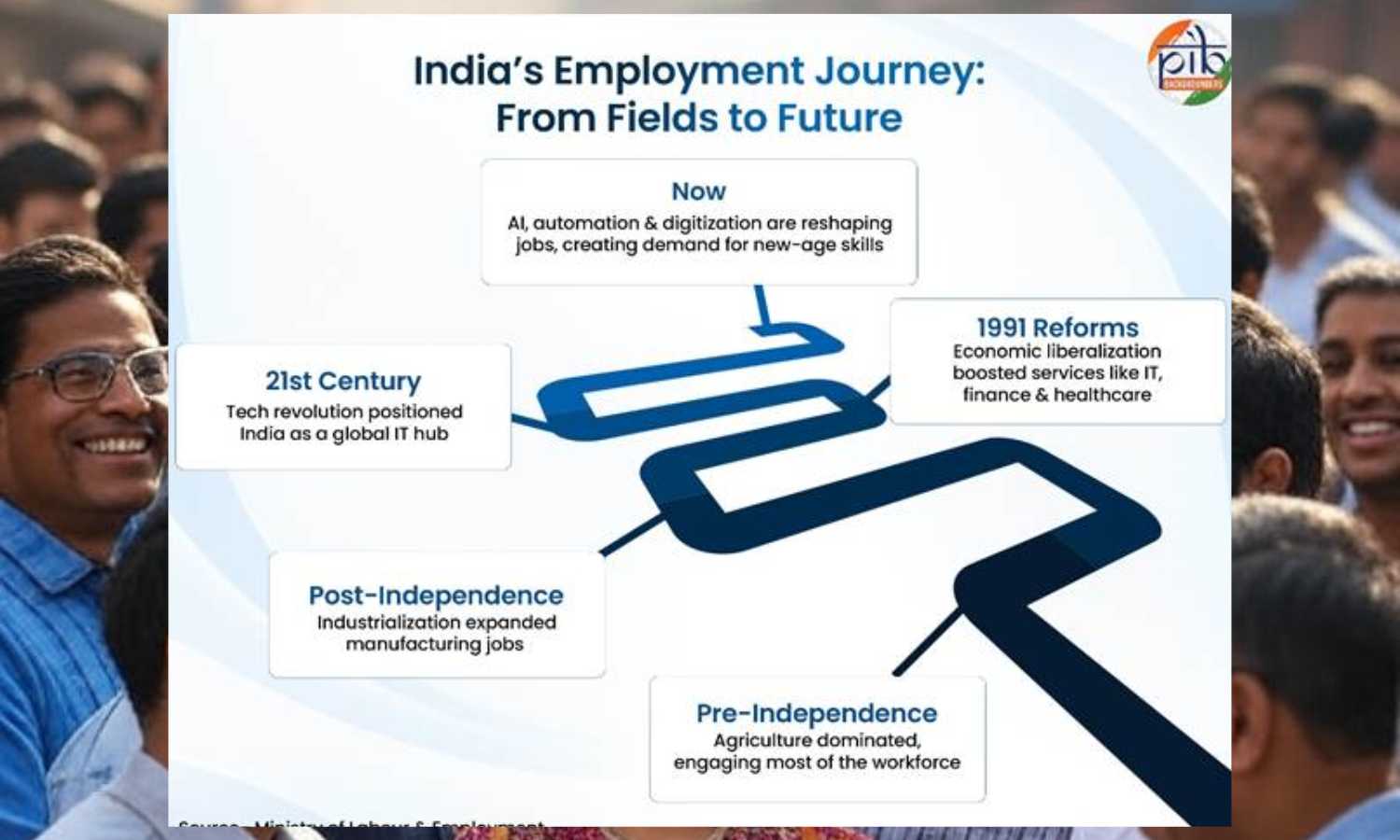New Delhi: India has added 16.83 crore new jobs in six years, reflecting sustained India employment growth supported by expanding industries, skill development, and rising female workforce participation. Data from the Ministry of Labour and Employment shows total employment reached 64.33 crore in 2023–24, compared to 47.5 crore in 2017–18, a net increase of 17 crore jobs.
The unemployment rate fell sharply from 6.0% in 2017–18 to 3.2% in 2023–24, while the number of women in formal employment rose by 1.56 crore during the same period. These indicators underscore India’s progress as one of the world’s fastest-growing economies and its focus on inclusive development under the Viksit Bharat vision.
Government data and independent labour surveys attribute the improvement to targeted welfare programmes, stronger formalisation, and higher participation across sectors.
Labour market reforms and workforce formalisation drive employment
To track workforce trends, the National Statistics Office (NSO) conducts the Periodic Labour Force Survey (PLFS). Its August 2025 estimates, based on inputs from 3.77 lakh individuals nationwide, show steady improvement in key employment indicators.
Between June and August 2025, the Labour Force Participation Rate (LFPR) for those aged 15 years and above increased from 54.2% to 55%, and the Worker Population Ratio (WPR) rose from 51.2% to 52.2%. Over the longer term, India’s LFPR climbed from 49.8% in 2017–18 to 60.1% in 2023–24, while WPR improved from 46.8% to 58.2%.
The rise reflects stronger workforce engagement in both rural and urban areas. In April–June 2025, the agriculture sector continued to employ most rural workers — 44.6% of men and 70.9% of women — while in urban areas, the tertiary sector employed 60.6% of men and 64.9% of women.
Formalisation also gathered pace. In 2024–25, the Employees’ Provident Fund Organisation (EPFO) added 1.29 crore new subscribers, compared to 61.12 lakh in 2018–19. Since September 2017, total net additions reached 7.73 crore, including 21.04 lakh in July 2025 alone. Around 60% of new members were aged between 18 and 25 years, reflecting youth-centric employment expansion.
The government said the rise in formal employment shows widening social security coverage and the success of schemes encouraging registered jobs. Self-employment also increased — from 52.2% in 2017–18 to 58.4% in 2023–24 — while casual labour declined from 24.9% to 19.8%, highlighting a shift toward entrepreneurship and independent work.
Wages, gender inclusion, and gig economy expansion
Average daily wages for casual labourers rose from ₹294 in 2017 to ₹433 in 2024, while monthly earnings of regular salaried workers climbed from ₹16,538 to ₹21,103. These wage improvements, combined with formalisation, have enhanced job quality and household income.
The fall in unemployment is equally notable. The national unemployment rate declined from 6% in 2017–18 to 3.2% in 2023–24, while youth unemployment fell from 17.8% to 10.2%, below the global average of 13.3%. In August 2025, the rural unemployment rate dropped to 4.3%, continuing a three-month decline, and urban male unemployment fell to 5.9%.
Women’s participation showed remarkable improvement. The female LFPR increased from 23.3% in 2017–18 to 41.7% in 2023–24, and WPR for women rose from 22% to 40.3%. In 2024–25, the EPFO added 26.9 lakh net female subscribers, while 2.8 lakh new female members joined in July 2025 alone.
Government initiatives such as Mission Shakti, Namo Drone Didi, and the Lakhpati Didi scheme have further encouraged women’s participation by combining livelihood support, training, and entrepreneurship.
Technology, startups, and skill-driven sectors boost India employment growth
India’s job market has diversified with emerging industries such as healthtech, fintech, e-commerce logistics, ed-tech, and renewable energy creating new employment opportunities. These sectors are particularly conducive for women and digitally skilled youth.
The gig economy is a defining feature of this growth. India’s gig workforce, currently around 1 crore, is projected to rise to 2.35 crore by 2029–30. The government has supported platform workers through the Code on Social Security (2020) and the e-Shram portal, where 31.2 crore workers are now registered.
India’s startup ecosystem, with 1.9 lakh DPIIT-recognized startups, has created over 17 lakh jobs and produced 118 unicorns as of 2025. Simultaneously, Global Capability Centres (GCCs) employing over two million professionals are expected to expand significantly by 2030 as India becomes the “GCC Capital of the World.”
Government programmes supporting employment generation
The government’s skilling and employment initiatives have been pivotal to India’s workforce transformation.
Key programmes include:
- Skill India Mission, training youth through nationwide re-skilling and up-skilling centres.
- Rozgar Melas, connecting job seekers and employers, providing 11 lakh placements in 16 months.
- PM Vishwakarma, supporting 30 lakh artisans with verified skill certification.
- ITI Upgradation Scheme, launched in May 2025, upgrading 1,000 institutes to train 20 lakh youth.
- Employment Linked Incentive (ELI) Scheme, targeting 3.5 crore jobs over two years with an outlay of ₹1 lakh crore.
- MGNREGA, with ₹86,000 crore allocation in FY 2025–26 for rural livelihoods.
- Pradhan Mantri Viksit Bharat Rojgar Yojana (PMVBRY), launched in August 2025, supporting 4.5 crore new and additional jobs through employer incentives until FY 2031–32.
These efforts align with India’s broader push to modernise its labour market, ensure social security, and enhance employability through public–private partnerships.
Employment outlook and conclusion
Experts note that sustainable job creation depends on linking skill development with industrial demand, promoting diversity, and integrating green technologies. The rise of GCCs, automation, and digitalisation is driving a workforce shift toward technology-enabled services.
India’s employment trajectory demonstrates strong resilience. With employment up 17 crore, unemployment halved, and women’s participation doubling, the country continues to reinforce its position as one of the world’s most dynamic labour markets.
Backed by a decade of reforms and governance measures, India employment growth stands as a key pillar of its medium-term economic success and inclusive development vision under Viksit Bharat 2047. (Source: PIB)

